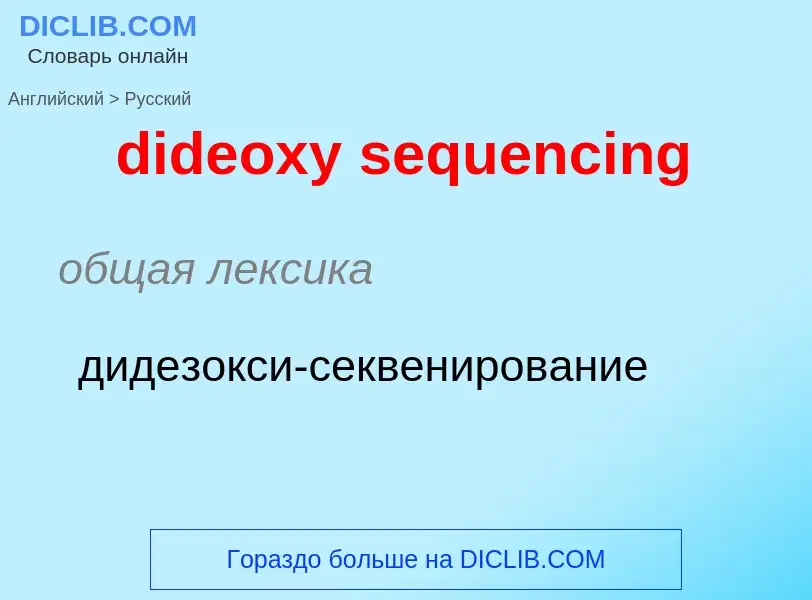Перевод и анализ слов искусственным интеллектом ChatGPT
На этой странице Вы можете получить подробный анализ слова или словосочетания, произведенный с помощью лучшей на сегодняшний день технологии искусственного интеллекта:
- как употребляется слово
- частота употребления
- используется оно чаще в устной или письменной речи
- варианты перевода слова
- примеры употребления (несколько фраз с переводом)
- этимология
dideoxy sequencing - перевод на русский
общая лексика
дидезокси-секвенирование
общая лексика
секвенирование ДНК
общая лексика
последовательность оснований (в нуклеиновых кислотах)
['si:kwənsiŋ]
общая лексика
секвенирование (определение первичной структуры макромолекул)
упорядочение
техника
программирование
Смотрите также
существительное
техника
программирование
Смотрите также
общая лексика
секвенирование методом "выстрела из дробового ружья" (метод определения первичной нуклеотидной последовательности с использованием крупных стохастических фрагментов с перекрывающимися последовательностями)
общая лексика
расщепление (пептидов) по Эдману
общая лексика
двугорбый верблюд
бактриан (Camelus bactrianus)
Определение
Википедия
DNA sequencing is the process of determining the nucleic acid sequence – the order of nucleotides in DNA. It includes any method or technology that is used to determine the order of the four bases: adenine, guanine, cytosine, and thymine. The advent of rapid DNA sequencing methods has greatly accelerated biological and medical research and discovery.
Knowledge of DNA sequences has become indispensable for basic biological research, DNA Genographic Projects and in numerous applied fields such as medical diagnosis, biotechnology, forensic biology, virology and biological systematics. Comparing healthy and mutated DNA sequences can diagnose different diseases including various cancers, characterize antibody repertoire, and can be used to guide patient treatment. Having a quick way to sequence DNA allows for faster and more individualized medical care to be administered, and for more organisms to be identified and cataloged.
The rapid speed of sequencing attained with modern DNA sequencing technology has been instrumental in the sequencing of complete DNA sequences, or genomes, of numerous types and species of life, including the human genome and other complete DNA sequences of many animal, plant, and microbial species.
The first DNA sequences were obtained in the early 1970s by academic researchers using laborious methods based on two-dimensional chromatography. Following the development of fluorescence-based sequencing methods with a DNA sequencer, DNA sequencing has become easier and orders of magnitude faster.


![sequencing of proteins]], and the other for the sequencing of DNA. sequencing of proteins]], and the other for the sequencing of DNA.](https://commons.wikimedia.org/wiki/Special:FilePath/Frederick Sanger2.jpg?width=200)












![alt=Two at the [[Cotswold Wildlife Park]] in England alt=Two at the [[Cotswold Wildlife Park]] in England](https://commons.wikimedia.org/wiki/Special:FilePath/Bactrian.camel.twice.arp.jpg?width=200)
![Tang]] general [[Liu Tingxun]] Tang]] general [[Liu Tingxun]]](https://commons.wikimedia.org/wiki/Special:FilePath/British Museum, London camel tang.jpg?width=200)
.jpg?width=200)
![alt=[[Skeleton]] alt=[[Skeleton]]](https://commons.wikimedia.org/wiki/Special:FilePath/Camel skeleton at MAV-USP.jpg?width=200)
![Riding in [[Nubra Valley]], India Riding in [[Nubra Valley]], India](https://commons.wikimedia.org/wiki/Special:FilePath/Riding Bactrian camel Nubra.jpg?width=200)

![alt=[[Chuya Steppe]], Altai Mountains, Russia alt=[[Chuya Steppe]], Altai Mountains, Russia](https://commons.wikimedia.org/wiki/Special:FilePath/Camels in Kosh-Agachsky District.jpg?width=200)

![Farm in [[Central Mongolia]] Farm in [[Central Mongolia]]](https://commons.wikimedia.org/wiki/Special:FilePath/Camel Farm in Mongolia 02.jpg?width=200)
![Farm in [[Vermont]], US Farm in [[Vermont]], US](https://commons.wikimedia.org/wiki/Special:FilePath/SpeakingCamel altColour US7FerrisburghVT 20151011 (39646557970).jpg?width=200)
![alt=In the snow at [[Tallinn Zoo]], Estonia alt=In the snow at [[Tallinn Zoo]], Estonia](https://commons.wikimedia.org/wiki/Special:FilePath/Bactrian camel (Camelus bactrianus) in Tallinn Zoo (March 2023).jpg?width=200)
